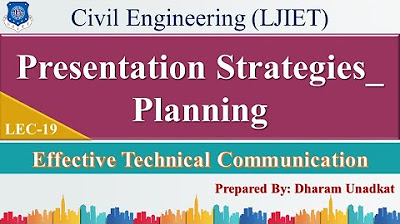Presentation Prep copy
Summary
TLDRThis script delves into the intricacies of presentation preparation, emphasizing the importance of thorough planning for various types of presentations: informative, instructional, persuasive, progress updates, motivational, and decision-making. It outlines key steps in preparation, including topic selection, goal setting, audience analysis, research, and crafting the presentation body. The speaker also discusses the significance of a compelling introduction and the strategic use of visual aids, tailored to different learning styles, to effectively engage the audience and convey the message.
Takeaways
- 📝 Preparation is key: Spending more time preparing for a presentation leads to better outcomes and makes the presentation easier to deliver.
- 🔍 Types of presentations: There are various types including informative, instructional, persuasive, progress updates, motivational, and decision-making presentations.
- 🎯 Selecting a topic: Choose a topic based on personal interest, audience interest, current events, and personal learning goals.
- 🎯 Presentation goals: Establish clear and specific goals for the presentation, such as informing about a specific issue or persuading the audience to take action.
- 📣 Thesis statement: Craft a concise thesis statement that is clear and compelling, akin to a tweet that would attract attention.
- 👥 Audience analysis: Understand the audience's knowledge level, perception of the speaker, reasons for attending, and environmental factors that may affect their receptiveness.
- 🔬 Research: Ensure the research is current, relevant, authoritative, and unbiased to support the presentation effectively.
- 📖 Introduction: Capture the audience's attention within the first 60 seconds using storytelling, questions, statistics, quotes, visual aids, or videos.
- 🎨 Visual aids: Use visual aids to cater to different learning styles, keeping them simple, clear, and clutter-free to enhance comprehension.
- 📚 Practice: Practice is essential to refine the presentation and ensure smooth delivery.
Q & A
What are the different types of presentations mentioned in the script?
-The script mentions five types of presentations: informative, instructional, persuasive, progress or update, and motivational.
Why is it important to spend more time preparing for a presentation?
-Spending more time preparing for a presentation ensures that it will go better and makes it easier to deliver. It involves selecting a topic, setting goals, analyzing the audience, conducting research, and practicing.
What is the purpose of an informative presentation?
-The purpose of an informative presentation is to provide information with no need for action, similar to a lecture where attendees might take notes but are primarily there to learn.
How does an instructional presentation differ from an informative one?
-An instructional presentation involves guiding the audience through a process, such as learning a new skill or software, whereas an informative presentation is more about sharing knowledge.
What is the usual goal of a persuasive presentation?
-The goal of a persuasive presentation is to convince the audience to take action or change their perspective, often ending with a call to action.
Can you explain the significance of a progress or update presentation?
-A progress or update presentation is used to report on the status of a project or task, ensuring everyone is on the same page regarding timelines and goals.
What is the main objective of a motivational presentation?
-The main objective of a motivational presentation is to inspire and energize the audience to take action or feel more positive about a subject.
How does the script suggest selecting a topic for a presentation?
-The script suggests selecting a topic based on personal interest, audience interest, the presenter's ability to inform or persuade, and current events that are relevant.
What is the importance of having a specific goal for a presentation?
-Having a specific goal ensures that the presentation is focused and that the audience knows what they are expected to take away from it.
Why should a thesis statement be 'Twitter friendly' as suggested in the script?
-A thesis statement should be concise and easily digestible, similar to a tweet, to quickly communicate the main point of the presentation to the audience.
How does the script recommend analyzing the audience for a presentation?
-The script recommends considering the audience's knowledge level on the topic, their perception of the presenter, their reasons for attending, and any environmental factors that might affect their receptiveness.
What factors should be considered when researching for a presentation?
-When researching, consider the currency of the research, its relevance to the presentation, the authority of the source, the trustworthiness of the data, and the purpose behind the data collection.
Why is it crucial to grab the audience's attention within the first 60 seconds of a presentation?
-Capturing the audience's attention early is crucial because it sets the tone for the presentation and encourages the audience to continue listening.
What are some effective methods to use for visual aids during a presentation?
-Effective visual aids include using simple slides, clear text, avoiding clutter, and considering different learning styles, such as incorporating charts, graphs, or videos for visual learners.
Outlines

Cette section est réservée aux utilisateurs payants. Améliorez votre compte pour accéder à cette section.
Améliorer maintenantMindmap

Cette section est réservée aux utilisateurs payants. Améliorez votre compte pour accéder à cette section.
Améliorer maintenantKeywords

Cette section est réservée aux utilisateurs payants. Améliorez votre compte pour accéder à cette section.
Améliorer maintenantHighlights

Cette section est réservée aux utilisateurs payants. Améliorez votre compte pour accéder à cette section.
Améliorer maintenantTranscripts

Cette section est réservée aux utilisateurs payants. Améliorez votre compte pour accéder à cette section.
Améliorer maintenantVoir Plus de Vidéos Connexes

Lecture 19_Presentation Strategies | Effective Technical Communication | Civil Engineering

Komunikasi bisnis - Presentasi Bisnis part 1

Technology Innovation - What is Innovation?

KOMIK EPS 27 Kampanye Persuasif

Workshop Public Speaking (Sesi 2 Manajemen Public Speaking) | SP2KM

KELOMPOK 5 SPS2 ASPEK MANAJEMEN DAN SDM
5.0 / 5 (0 votes)
